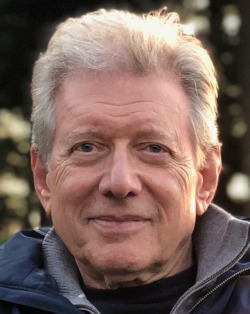
Saturday, March 7, 2020, 9:00 AM - 4:00 PM
6.0 LIVE CE Credits - Intermediate Level
The Psychology of Narcissism: Psychoanalytic Perspectives of Freud, Kohut, and Kernberg
Presenter: Peter Wolson, Ph.D.
Held at The New Center for Psychoanalysis
2014 Sawtelle Blvd.
Los Angeles, CA 90025
Program fees include light breakfast and afternoon snack
LACPA Members $160 LACPA Student Members $75
Non-Members $200 Student Non-Member $100*
*Must submit proof of current student status.
This program will be filmed for later on-demand viewing.
Pre-registration ended March 2nd
On-site registration is available at an additional $20.00.
We suggest parking at The Olympic Collection.
Effective psychotherapy requires a deep understanding of the unconscious psychodynamics of a patient’s narcissism, i.e., “self.” This workshop explores the three most prominent theories of narcissism in the field of psychoanalysis: Sigmund Freud’s classical conceptions, Heinz Kohut’s “self psychology” and Otto Kernberg’s object relations model of the “pathological grandiose self.” The diagnostic indications and treatment strategies for each of these theories will be elaborated, allowing us to compare and contrast them.
Peter Wolson, Ph.D. is a training and supervising analyst and faculty member of the Los Angeles Institute and Society for Psychoanalytic Studies. He has served as LAISPS’ President and Director of Training, is a co-founding member of the Confederation of Independent Psychoanalytic Societies, is a Fellow of the International Psychoanalytical Association and is a past-President of the Los Angeles Society of Clinical Psychologists. He is on the resident faculty of the Wright Institute Los Angeles, and is in private practice in Beverly Hills.
This workshop explores three of the major psychoanalytic theories of narcissism, Sigmund Freud's seminal concepts, Heinz Kohut's "self psychology" and Otto Kernberg's "pathological narcissism."
We will focus on the most pivotal diagnostic and treatment issues for each theory, comparing and contrasting its clinical applicability as we proceed.
We will start with Freud’s theory of psychological creation, his conception of how the internal world of self and object representations initially come into being. This involves his seminal constructs of primary and secondary narcissism, ego libido and object libido, anaclitic love and narcissistic love, and how his psychosexual theory of infantile development might lead to healthy or regressive narcissism. We will then explore Kohut’s “self psychology,” its emphasis upon psychological deficit and developmental arrest, the grandiose, alterego and idealizing selves and their associated self-object functions that are considered necessary for the development of a cohesive, integrated self-structure. Lastly, we will investigate Kernberg’s “pathological grandiose self,” how this aberrant mental structure is caused by severely frustrating external and internal object relations at the beginning of life.
COURSE GOALS AND EDUCATIONAL OBJECTIVES
The attendees will be able to:
1. Define and differentiate primary narcissism from secondary narcissism
2. Describe Freud’s conception of how self and object representations develop.
3. Recognize clinical indications of Kohut’s grandiose and idealizing selves
4. Identify and treat selfobject transference ruptures
5. Diagnose a pathological grandiose self
6. Interpret the defenses of a pathological grandiose self
COURSE OUTLINE
1. Introduction (10-15 min.)
a. LACPA intro
b. Personal intro
2. Freudian Theory (15 min)
a. Importance of narcissism for clinical work: self and object representations
b. Myth of Narcissus and definition of narcissism
c. Narcissistic personality vs. borderline personality disorder
3. Freud’s evolving theory of narcissism (45 min)
i. Three models of narcissism
ii. Psychoanalytic story of psychic creation of internal self and object representations
1. Primary narcissism and primary identification-the baby as god.
2. The regression curve- the older one gets, the harder one must work for less attention and reward
3. Separation-individuation: the purified pleasure ego, perceptual-motor development, the “good enough” mother.
4. Secondary narcissism
5. Genesis of the ego-ideal
a. The body ego.
b. Anal stage- internalizing values of parents
c. Phallic-Oedipal stage: Idealization, introjection and identification.
d. Consequences of Oedipal victory. Clinical examples
6. Consequences of becoming object related and renouncing narcissism.
7. Real love: ego-libido and object libido (30 min)
8. Two types of object love
a. Anaclitic object choice
b. Narcissistic object choice
9. The case of Mr. Z. (Brief description)
10. Q & A
3. Break (15 min.)
4. Kohut’s “self psychology.” (1 hr.)
a. Intro
b. Selfobject vs. libidinal object
c. Deficit model vs. conflict model
d. The bipolar self (tripolar self): grandiose self, alter-ego, idealizing self and their selfobject functions.
e. Developmental phases:
i. Merging and mirroring (oral)
ii. Adversarial and efficacy (anal)
iii. Idealizing (phallic-Oedipal)
iv. Alterego (latency)
f. Kohutian version of the Oedipus complex
g. Empathy: experience near vs. experience distant
h. Symptoms of self-fragmentation
i. Defensive structures: compensatory, vertical and horizontal splits.
j. Lunch break (1 hr.)
5. Kohut continued. (1 hr.)
a. Kohut’s version of the Oedipus complex
b. Narcissistic rage vs. Oedipal rage
c. Freudian drives vs. Kohutian products of narcissistic fragmentation
d. Treatment strategies:
i. Selfobject transferences
ii. Self-selfobject transference ruptures
iii. Defensive regression
iv. Transference restoration
v. Empathic acceptance of transference blame
vi. Empathy and explanation
vii. Treatment formula
e. Q & A
6. Otto Kernberg’s “Pathological Grandiose Self (PGS)” (2 hrs)
a. Based on Kleinian object relations and American ego psychology
b. Formula for the PGS
c. Symptoms of a PGS
d. Childhood etiology
e. A general defense against dependency, oral rage, envy, paranoia, archaic guilt and the vulnerability of loving
f. Specific defenses of the PGS: idealization, devaluation, omnipotent control and denial
g. Pathological narcissism during therapy
h. Treatment of pathological narcissism
i. Cultivating a working alliance
ii. What the patient needs to understand
iii. Interpreting:
1. Narcissistic defenses and fears
2. Positive aspects of the patient
3. Aggressive and libidinal aspects of the transference
7. Break (15 min)
8. Continuing Kernberg (1 hr.)
a. Clinical vignettes from Kernberg
b. Countertransference dangers and benefits
c. Malignant narcissism
i. Definition
ii. Characteristics
iii. Differential diagnosis
iv. Etiology
v. Paranoid regression
vi. Self-destructiveness as triumph over analyst
vii. Treatment strategy
viii. Comparative summary
ix. Q & A
Program, presenter, date, and location are all subject to change.
Cancellation Policy: To receive a refund, a written request must be received the Monday before the scheduled date of the program. Refunds will be processed within 30 days.
A $35 processing fee is deducted from all refunds. Should it become necessary to cancel a course, those who have registered will be notified in writing, and the full course fee will be refunded.
It is important to note that APA continuing education rules require that LACPA only give credit to those who attend the entire workshop. An evaluation of the workshop must be completed. Those who arrive more than 15 minutes after the scheduled start time or leave before the workshop is completed will not receive CE credit. Partial credit may not be given. CE Certificates will be sent out via email within two weeks from the program.
The Los Angeles County Psychological Association (LACPA) is approved by the American Psychological Association to sponsor continuing education for psychologists.
LACPA maintains responsibility for this program and its content.
This course may be taken to satisfy the California Board of Behavioral Sciences (BBS) continuing education requirements.


 Prev Month
Prev Month View Month
View Month Search
Search Go to Month
Go to Month Next Month
Next Month

 Export Event
Export Event